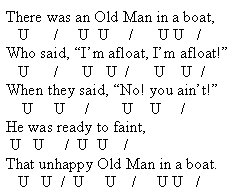By Brenda B. Covert

|
Limericks
By Brenda B. Covert |

|
| a 4 a 5 b 6 b 7 a |

| There once was a lady from Koo, | ||||||||||||||||||||||||||
| Who woke up all covered in adhesive._______________ Paragraphs 14 to 31: For the complete story with questions: click here for printable Weekly Reading Books
Feedback on Limericks
Clouds
Weather
More Lessons
Science
Copyright © 2018 edHelper |